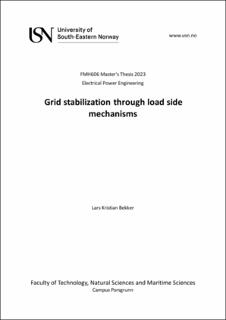| dc.description.abstract | The composition of the power systems is subject to change, both on the generation and load side. On the generation side there is an increase in renewable energy sources that are connected to the power system with power electronic converters, the same is seen for the load, that the load is connected by means of power electronic converters. Because of this, the kinetic energy is decreasing, and the harmonic and reactive power is increasing. This affects the stability and the voltage control of the power system. But the increase in power electronic converters also leads to that the load is moving from being passive towards active.
This thesis investigates how a large load hydrogen production facility can contribute to stabilize a power system. The objectives are to investigate what market mechanisms exist at different geographical locations, how are the different power markets and how do they compare, and what properties the consumer needs to have to deliver these services. For resolving the objectives, a literature study was performed. The literature study shows that a hydrogen production facility is applicable for the ancillary services available today and can contribute to stabilizing a power system. | |
